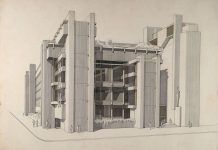The beaux-arts style was a way of building that originated in the school of fine arts set up in Paris in the early 19th century. For the French this carefully composed, highly ornate classical style was closely associated with architectural education. Elsewhere in the world it became an immensely popular style, applied widely to all types of structures, from public buildings to banks.
Like most practitioners of the arts and crafts, architects originally learned their job in a kind of apprenticeship system. A young man (architecture was in its early days an almost exclusively male preserve) would join the office of an established architect and work as a junior, gradually learning the skills of drawing and design. With a good and giving master, it was a system that could work well, but some wanted a more formal system of training leading to a qualification, so that architecture became a profession.
The French academies
France was one of the first countries to create such a formal system of teaching architecture. The first French architectural school was the Académie Royale d’Architecture, which was founded in 1671 by Louis XIV’s chief financial minister, Jean-Baptiste Colbert.
During the French Revolution, the Académie, with its royal links, was closed, and a few years later, in 1803, Napoleon founded the Ecole des Beaux-Arts to offer training in the fine arts. The school continued to dominate French architectural education throughout the 19th century, but was also increasingly influential in other countries, fostering a style of building that proved popular in the USA, in other American countries and in many parts of Europe.
Grand Prix de Rome
The system of awarding the prize of a study-visit to Rome for young architects (and to practitioners of the other arts) was at the heart of French culture. It emphasized that the ultimate foundation of artistic knowledge was to be found in the classical world, and gave the most talented (and those most able to satisfy the tastes of the judges) a direct route to the source. Candidates had first to produce a sketch of their solution to a set design problem. They then worked this up into a more finished presentation called a charrette (the world means “cart,” because you needed one to carry your drawings, models and other materials to the presentation), and finally the best eight were selected to work up their ideas into a full project. The winner was sent to Rome for a year to study the architecture and work on their own projects.
Spaces and styles
The architectural education provided by the Ecole des Beaux-Arts had two influential aspects. First, it promoted a very specific way in which architects were expected to handle space. Students learned to treat the spaces or rooms in a building in a hierarchy, to deploy them symmetrically and to arrange them along axes that passed through the building. They were encouraged to consider the effect these rooms made as one passed from one to another. This way of looking at buildings as series of spaces, and controlling the way these spaces interacted, was hugely influential.
The second aspect of the beaux-arts training was to do with the physical appearance and finish of the buildings. A classical beaux-arts style developed, relying heavily on the influence of classical and neoclassical architecture, and was widely imitated. Buildings were symmetrical, raised on a rusticated lower story, and eclectically classical. Their style featured roofs hidden behind parapets, rows of often round-headed windows, elaborately treated doorways with classical door cases and the widespread use of classical decorative details, such as pilasters, brackets and cartouches. The beaux-arts architects liked to make their buildings still grander and more ornate with the use of statuary.
Architecture and professionalism
By pioneering architectural education, the beaux-arts school (below) was an important factor in making architecture into a profession. The professional status of architecture in France was confirmed in 1840 when the Société Centrale des Architects was founded. In Britain, the key professional body was the Royal Institute of British Architects (set up in the 19th century), while in America the American Institute of Architects was founded in 1857.
The beaux-arts style flourished in France during the 19th century. It proved ideal for the type of grand public buildings that were put up in increasing numbers in Paris and other major cities—the Opéra Garnier and the Ecole des Beaux-Arts itself are major examples. In England the style was especially influential in the Edwardian period. As well as one prominent architect, Arthur J. Davis (one of the designers of London’s Ritz Hotel), who was educated at the Ecole, many others caught the bug, and elaborate beaux- arts classical buildings became one of the hallmarks of the Edwardian cities.
“The Beaux-Arts method was so successful it attracted students from all over the world …” John F. Pile, A History of Interior Design
Beaux-arts outside Europe
But the style spread much more widely. It was especially popular in the USA, where architects such as Richard Morris Hunt and the practice of McKim, Mead and White were well known advocates. McKim, Mead and White’s enormous Pennsylvania Station in New York (demolished in the 1960s) was one of the greatest examples; Boston Public Library is one of the beaux-arts survivors.
The beaux-arts style spread throughout the world, standing for sophistication and good design wherever Europeans settled and carried their culture—from Argentina to Egypt, Canada to Japan. It survived well into the 20th century because the image it created was popular among all types of clients, from governments to banks. But the style was often bastardized—designers copied the mannerisms and decoration, but ignored the fundamental beaux-arts teaching about the arrangement of spaces. This, and the reliance of the style on lavish decoration, made the beaux-arts manner a target of the modernists, who replaced it with what they saw as a greater awareness of structure and function, and a rejection of ornament. After a long run, beaux-arts had had its day.




















